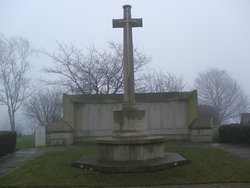
GRAY, Alfred
| Service Number: | 3766 |
|---|---|
| Enlisted: | Not yet discovered |
| Last Rank: | Private |
| Last Unit: | 6th Infantry Battalion |
| Born: | Long Gully, Bendigo, Victoria, Australia, 1871 |
| Home Town: | South Melbourne, Port Phillip, Victoria |
| Schooling: | Not yet discovered |
| Occupation: | Labourer |
| Died: | Cardiac disease, 3rd Northern General Hospital, Sheffield, England, United Kingdom, 16 August 1916 |
| Cemetery: |
Sheffield (Burngreave) Cemetery, England Memorial. F9. "C." 5. Screen Wall |
| Memorials: | Australian War Memorial Roll of Honour, South Melbourne Great War Roll of Honor |
World War 1 Service
| 23 Nov 1915: | Involvement Private, 3766, 6th Infantry Battalion, Battle for Pozières , --- :embarkation_roll: roll_number: '8' embarkation_place: Melbourne embarkation_ship: HMAT Ceramic embarkation_ship_number: A40 public_note: '' | |
|---|---|---|
| 23 Nov 1915: | Embarked Private, 3766, 6th Infantry Battalion, HMAT Ceramic, Melbourne |
Help us honour Alfred Gray's service by contributing information, stories, and images so that they can be preserved for future generations.
Add my storyBiography contributed by Geoffrey Gillon
Alfred was born Long Gully, Bendigo, Victoria; brother of R Gray (nok), 112 Thistlewaite Street, South Melbourne, Victoria. He enlisted in the Australian Imperial Force on 9 July 1915 and embarked from Melbourne for active service abroad on 23 November 1915 per HMAT "Ceramic" (A40). He died of cardiac disease at the 3rd Northern General Hospital, Sheffield, England, aged 45 years. He was buried on 19th August 1916.
Biography contributed by Cathy Sedgwick
The summary below was completed by Cathy Sedgwick (OAM) – Facebook “WW1 Australian War Graves in England/UK/Scotland/Ireland”
Alfred Gray was born at Long Gully, Bendigo, Victoria around 1871.
He enlisted in the Australian Imperial Force (A.I.F.) on 5th July, 1915 as a 44 year old, single, Labourer from 112 Thistlewaite Street, South Melbourne, Victoria.
Private Alfred Gray, Service number 3766, embarked from Melbourne, Victoria on HMAT Ceramic (A40) on 23rd November, 1915 with the 6th Infantry Battalion, 12th Reinforcements.
He was written up on 26th February, 1916 while posted at Zeitoun for disobedience of orders – leaving camp improperly dressed. He forfeited 1 days’ pay.
On 29th March, 1916 Private Gray embarked from Alexandria on H.T. Transylvania to join B.E.F. (British Expeditionary Force). He disembarked at Marseilles, France on 4th April, 1916.
Private Gray proceeded from 1st Australian Base Depot at Etaples on 10th June, 1916 to join his Unit & was taken on strength of 6th Battalion from Reinforcements in France on 11th June, 1916.
He was admitted to 1st Field Ambulance on 24th June, 1916 with Haemorrhoids then transferred & admitted to 1st Australian Casualty Clearing Station on 30th June, 1916. He was transferred to No. 1 Convalescent Depot at Boulogne, France on 3rd July, 1916. Private Gray was discharged to duty at Base Details on 4th July, 1916 as unfit. He was admitted to 1st Australian Divisional Base Depot at Etaples on 7th July, 1916.
On 21st July, 1916 Private Gray was admitted to No. 26 General Hospital at Etaples, France with Piles. He was marked for transfer to England on 12th August, 1916 & embarked for England on Hospital Ship Dieppe from Calais, France on 13th August, 1916.
Hewas admitted to 3rd Northern General Hospital, Sheffield, England on 13th August, 1916 with haemorrhoids.
Private Alfred Gray died on 16th August, 1916 at 3rd Northern General Hospital, Sheffield, England from “dilation of heart and anaesthesia arrest cardiac function.” (Note: some forms in the Service record file have that Private Gray died from wounds – but there are others where this has been crossed out & replaced with “died of disease.” There is no mention at all that he was wounded.)
He was buried in Burngreave Cemetery, Sheffield, South Yorkshire, England.
Due to the number of deaths and lack of available space in some cemeteries, numerous burials took place in what are known as common or mass graves. Private Gray was buried in a one of these common or mass graves. Behind the Cross of Sacrifice in plot JJ is a Screen Wall commemorating those First World War casualties whose graves could not be marked by headstones, most of them buried in the plot of ground immediately in front of it.
A Granite Memorial Cross was erected by the Royal British Legion at the common grave site where Private Gray was buried – Memorial F9. “C” 5. The names of those buried in this plot were engraved on the Granite Memorial Cross however, the names on the Granite Memorial Cross are not included on the CWGC Screen Wall. His death is still acknowledged by the Commonwealth War Graves Commission.
(The above is a summary of my research. The full research can be found by following the link below)
https://ww1austburialsuk.weebly.com/burngreave.html










